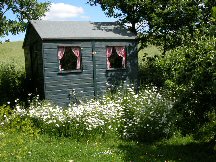
| Initially, the English cottage garden was constructed for its utilitarianism. As much space as possible was utilised for growing flowers, herbs, fruit and vegetables. Cottage gardens three or four hundred years ago would have been very unattractive, used for the growing of crops and the raising of poultry or pigs, for example. Over the decades, the cottage gardener started to grow fruit as well as vegetables and medicinal herbs to help treat common ailments. Wildflowers would seed themselves and be left to grow haphazardly. There was no room for lawns, just meandering paths between the planting areas. |  |
Therefore, the cottage garden has no formal plan. It is a riot of colour and plants crammed in wherever there is a space.Let plants self-seed themselves where they will and you will have no weeding to do as the weeds won't stand a chance against such closely-packed in plants. Any gaps can be filled in by sowing annuals, such as Snapdragons, Poppies and Cornflowers. Grow Hollyhocks beside walls and fences - but don't just confine them to the back because they are tall - plant them anywhere in your borders as height is irrelevant and tall plants don't have to be planted only at the back. Entwine Honeysuckle amongst any hedging you have or train it to grow through your trees. Avoid modern hybrids and double flowers - they are not traditional and have no wildlife value at all. Grow herbs by your kitchen door in pots and tubs so they are close at hand for cooking and medicine, or create a herb bed elsewhere in the garden, preferably near to the vegetable patch so that you can use the theory of companion planting to combat pests on your veggies. The cottage garden requires very little maintenance - there is virtually no weeding in an established garden, you do not need to cut down flower spikes when flowering is over as the birds will eat the seeds (and you want some to self-seed), and the veggie/fruit patch, if you have one will only require a minimum of attention. For a picture-postcard English cottage garden, add old metal pails and watering cans and lots of terracotta pots.